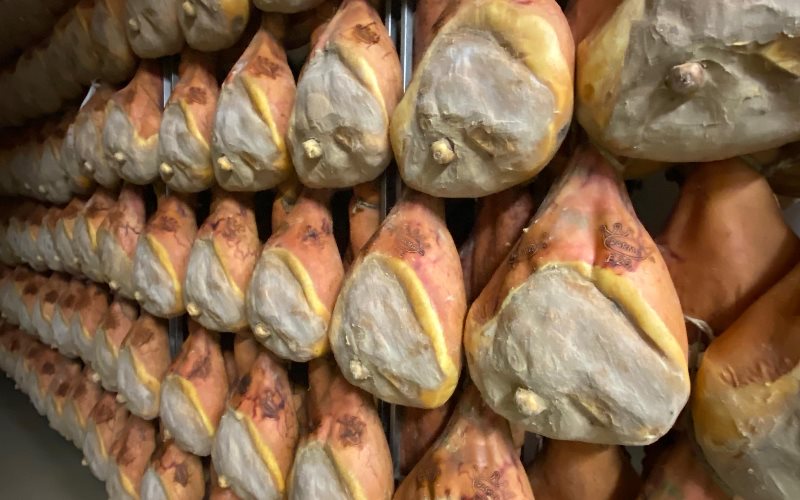
The History of Parma Ham
Sep 16, 2022
If you are looking for some Italian food to eat, whether you’re visiting the city of Parma or you’re at your local grocery store, maybe try some Prosciutto di Parma which in English is Parma Ham. For those of you who don’t know what Prosciutto di Parma is, it is an all-natural, gluten-free cured ham that is completely free of preservatives and GMOs, and made only from the hind legs of specialty-bred pigs and sea salt. Prosciutto di Parma can be dated back to the Etruscan period, when at that time, the populations settled in the Padan territories used a method involving the use of salt to preserve pork meat. The result was a kind of food not only appetizing but also extremely practical, which was Prosciutto di Parma. During the Middle Ages, the ‘beccai’ guild took care of meat processing in the Parma area and then in 1459 the ‘lardaioli’ guild, specialized in the treatment of pigs, was born. What would follow would be the creation of the Prosciutto di Parma PDO, or the Protected Designation of Origin.
Prosciutto di Parma PDO

Prosciutto di Parma PDO is a dry-cured charcuterie product, obtained through the processing of fresh legs of Italian Heavy Pigs. The term PDO originated in 1996 when it was assigned to Prosciutto di Parma by the European Union giving it the recognition of the product’s particular value and its indissoluble bond with the territory of origin. If you’re someone who worries about additives in foods then fear not because Prosciutto di Parma PDO is 100% natural, made without any additives, such as nitrates, nitrites, preservatives, hormones or coloring agents. You’ll love its mild and delicate taste and its roundish shape. Consider buying Prosciutto di Parma PDO!
Manufacture
Parma Ham is manufactured by the ‘Consorzio del prosciutto di Parma’ (Consortium for Parma Ham) which is the association of the most traditional producers of the famous Italian ham. It was founded in 1963 to guarantee its quality, defend it from imitation attempts and at the same time promote it in the world. The consortium makes sure that the ham is made to perfection as it is a kind of ham requiring not only high-quality meat, but also great skill in the different stages of its preparation. The stages are cooling, trimming, salting, resting, washing & drying, initial curing, greasing, final curing, and survey and branding.
What to look for at the grocery store?
This question is very easy to answer, when you’re at the grocery store looking for Prosciutto di Parma keep an eye out for the Parma Crown. You can find Prosciutto di Parma at an Italian deli or specialty food store, but the location for prosciutto will vary. National chains like Kroger, Trader Joe’s, Costco, and Whole Foods now carry it in their deli departments, where it can be sliced to order, or it may be found in pre-sliced refrigerated packages. Just check the deli departments, look for the Parma Crown and you’ll find Prosciutto di Parma in no time!
The history of Parma Ham

Parma Ham is the english translation for Prosciutto di Parma and it is one of the finest hams in the world. Parma ham is a unique process, with nothing more than pig meat, salt and 2,000 years of parmesan experience. The Consorzio checks every single Parma Ham and ensures the production and final result are up to standard before being branded with the certification trademark, the Ducal Crown. Parma ham is also very good for you as it is high in protein and free amino acids, giving it a high overall digestibility. The history for Parma Ham is very similar to Prosciutto di Parma since they’re both almost the same thing, we’ll touch on more on that in a bit. If you’re in Parma and want to know more about how Parma Ham is made, then consider booking one of our Parma Ham Farm Tours by clicking this link!
Use of Prosciutto di Parma

Prosciutto di Parma isn’t just great to eat on its own, it’s also perfect to pair with other foods! You can pair it with pizza, rustic bread, juicy melon, creamy mozzarella and much more. Use it to make a delicious parma ham and cheese sandwich, wrap it around fruit for appetizers, drizzle it with high-quality extra virgin olive oil for a simple bruschetta, or skewer it for the perfect antipasto on the go. As you can tell, there are so many ways to use Prosciutto di Parma that we could make an entire separate post on how you can use Prosciutto di Parma.
Parma Ham vs. Prosciutto
We had mentioned earlier that Parma Ham and Prosciutto di Parma are almost the same thing, there is a difference between the two. In order to avoid any confusion or making this sound complicated, to put it simply, any Parma ham is prosciutto, but not every Parma ham is prosciutto di Parma. Prosciutto is made from pork legs generously rubbed with salt and herbs. The meat is then left to rest in a cool place for a few weeks to remove the excess water. You are not supposed to use herbs in the preparation for Parma ham as its only ingredients are pork and salt. Another difference is while any pig breed can be used for regular Prosciutto, Parma ham is made only from Landrace and Duroc pigs. These are just a few key differences between Prosciutto and Parma Ham, but hopefully you’re now able to distinguish between the two.
Culatello

Culatello is one of Italy’s best known and most prized salumi that also comes from the province of Parma and received its PDO recognition the same year as Prosciutto di Parma! Culatello stands out amongst the most appreciated Italian raw food as it is a unique, limited edition product created in the land that gave birth to Giuseppe Verdi. It is typically served in restaurants along with other salumi as the “house appetizer,” in thin slices and accompanied by buttered toast. However, the best way to serve Culatello is with the classic “gnocco fritto” bread you find in Emilia Romagna, made with a dough of water, flour, salt and baking soda, cut into square or rectangular pieces and fried in lard. If you want to learn more about how Culatello is made and how it tastes, consider taking our Food tour at the Culatello factory by clicking this link! So the next time you’re in Parma and eating at one of their nice cuisines, consider ordering Culatello along with Prosciutto di Parma!
 Italian
Italian Spanish
Spanish French
French Chinese
Chinese German
German




